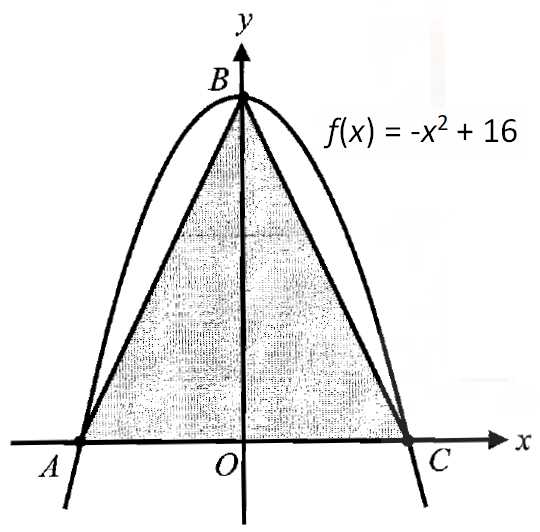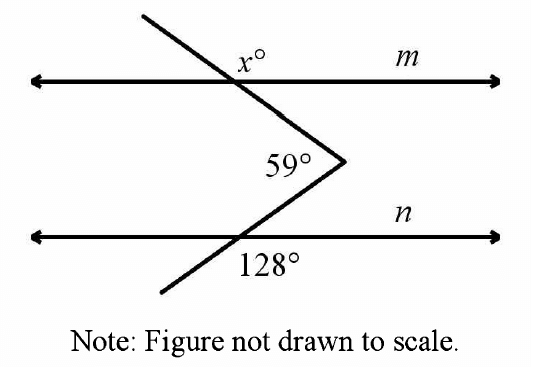How to Find f o g and g o f From the Given Relation
Definition :
Let f : A -> B and g : B -> C be two functions. Then a function g o f : A -> C defined by (g o f)(x) = g[f(x)], for all x ∈ A is called the composition of f and g.
Note : :
It should be noted that g o f exits if the range of f is a subset of g. Similarly, f o g exists if range of g is a subset of domain f.
Question 1 :
Let f : [2, 3, 4, 5] -> [3, 4, 5, 9] and g : [3, 4, 5, 9] -> [7, 11, 15] be functions defined as f(2) = 3, f(3) = 4, f(4) = f(5) = 5 and g(3) = g(4) = 7 and g(5) = g(9) = 11. Find g o f.
Answer :
Write the function f as a set of ordered pairs.
f = {(2, 3), (3, 4), (4, 5), (5, 5)}
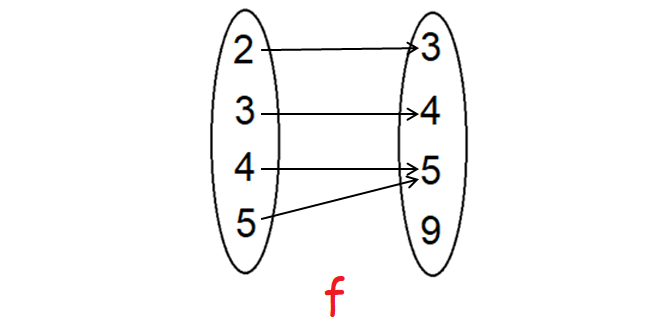
Write the function g as a set of ordered pairs.
g = {(3, 7), (4, 7), (5, 11), (9, 11)}
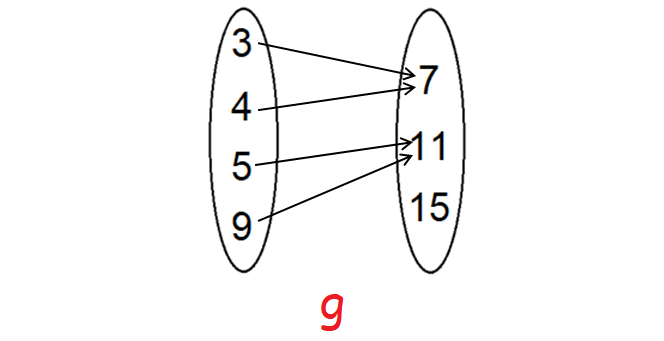
g o f can be denoted as
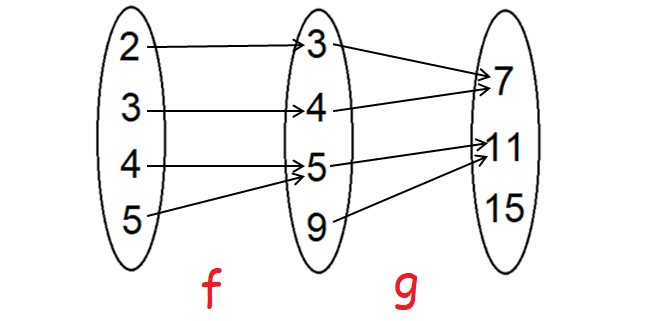
(g o f) (2) = 7
(g o f) (3) = 7
(g o f) (4) = 11
(g o f) (5) = 11
Therefore, g o f = {(2, 7), (3, 7), (4, 11), (5, 11)}.
Question 2 :
Let f : {1, 3, 4} -> {1, 2, 5} and g : {1, 2, 5} -> {1, 3} be given by f = {(1, 2) (3, 5) (4, 1)} and g = {(1, 3) (2, 3) (5, 1)}. Find g o f.
Answer :
f = {(1, 2) (3, 5) (4, 1)}
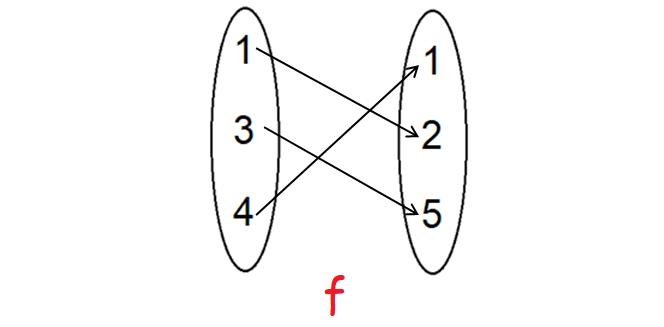
g = {(1, 3) (2, 3) (5, 1)}
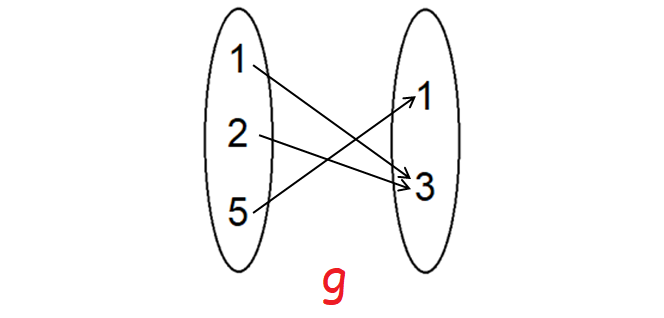
g o f can be denoted as
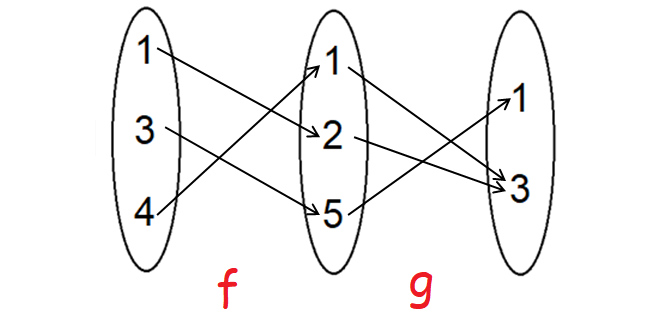
(g o f) (1) = 3
(g o f) (3) = 1
(g o f) (4) = 3
Therefore, g o f = {(1, 3), (3, 1), (4, 3)}.
Question 3 :
Let f = {(3, 1), (9, 3), (12, 4)} and g = {(1, 3), (3, 3), (4, 9), (5, 9)}. Show that g o f and f o g are defined. Also find f o g and g o f.
Answer :
f = {(3, 1), (9, 3), (12, 4)}
Domain of f = {3, 9, 12} and Range of f = {1, 3, 4}
g = {(1, 3), (3, 3), (4, 9), (5, 9)}
Domain of g = {1, 3, 4, 5} and Range of g = {3, 9}
If f o g is defined, then range of g must be a subset of domain of f. {3, 9} is a subset of {3, 9, 12}.
So, f o g is defined.
If g o f is defined, then range of f must be a subset of domain of g = {1, 3, 4} is a subset of {1, 3, 4, 5}.
So, g o f is defined.
g o f :
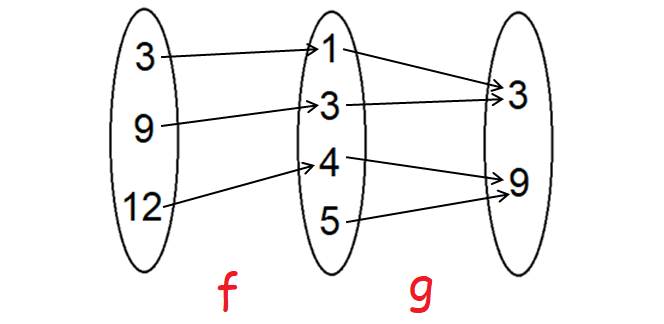
(g o f) (3) = 3
(g o f) (9) = 3
(g o f) (12) = 9
Therefore, g o f = {(3, 3), (9, 3), (12, 9)}.
f o g :
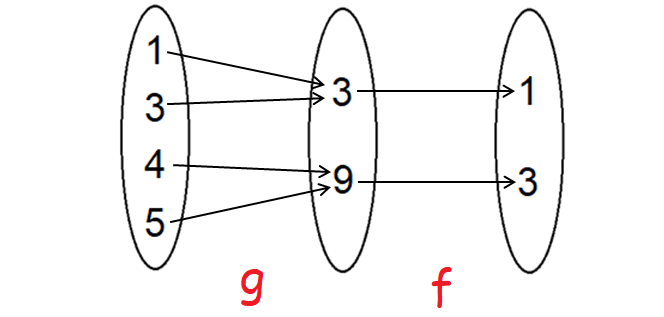
(f o g) (1) = 1
(f o g) (3) = 1
(f o g) (4) = 3
(f o g) (5) = 3
Therefore, f o g = {(1, 1), (3, 1), (4, 3), (5, 3)}.
Question 4 :
Let f = {1, -1), (4, -2), (9, -3), (16, 4)} and g = {(-1, -2), (-2, -4), (-3, -6), (4, 8)}. Show that g o f is defined while f o g is not defined. Also, find g o f.
Answer :
f = {1, -1), (4, -2), (9, -3), (16, 4)}
Domain of f = {1, 4, 9, 16} and Range of f = {-1, -2, -3, 4}
g = {(-1, -2), (-2, -4), (-3, -6), (4, 8)}.
Domain of g = {-1, -2, -3, 4} and Range of g = {-2, -4, -6, 8}
Since range of f is a subset of domain of g, g o f is defined.
Since range of g is not a subset of domain of f, f o g is not defined.
g o f :
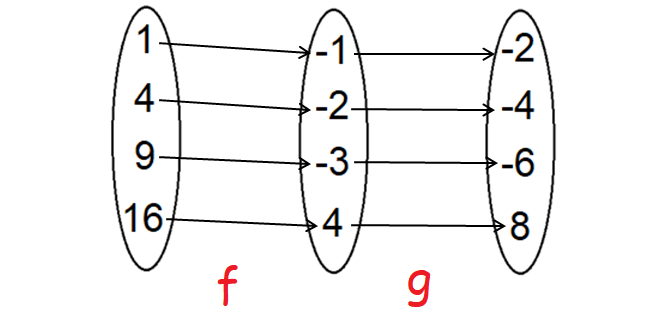
(g o f) (1) = -2
(g o f) (4) = -4
(g o f) (9) = -6
(g o f) (16) = 8
Therefore, f o g = {(1, -2), (4, -4), (9, -6), (16, 8)}.
Question 5 :
Find in the following table, given that h(x) = f(g(x))
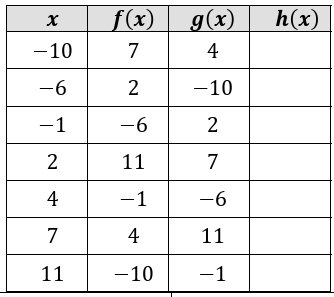
Solution :
Given that, h(x) = f(g(x))
|
When x = -10 h(-10) = f(g(-10)) = f(4) = -1 |
When x = -6 h(-6) = f(g(-6)) = f(-10) = 7 |
|
When x = -1 h(-1) = f(g(-1)) = f(2) = 11 |
When x = 2 h(2) = f(g(2)) = f(7) = 4 |
|
When x = 4 h(4) = f(g(4)) = f(-6) = 2 |
When x = 7 h(7) = f(g(7)) = f(11) = -10 |
When x = 11
h(11) = f(g(11))
= f(-1)
= -6
Question 6 :
Use the graph to find the following.
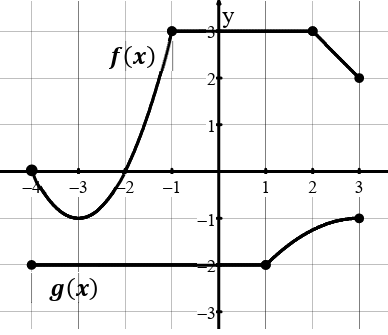
a) Find f(g(1))
b) Find (f o g)(3)
c) Find g(f(2))
Solution :
a) f(g(1)) = f(-2)
f(g(1)) = 0
b) (f o g)(3) = f[g(3)]
= f(-1)
(f o g)(3) = 3
c) g(f(2)) = g(3)
g(f(2)) = -1
Kindly mail your feedback to v4formath@gmail.com
We always appreciate your feedback.
©All rights reserved. onlinemath4all.com
Recent Articles
-
Digital SAT Math Problems and Solutions (Part - 143)
Apr 13, 25 12:01 PM
Digital SAT Math Problems and Solutions (Part - 143) -
Quadratic Equation Problems with Solutions
Apr 12, 25 08:21 PM
Quadratic Equation Problems with Solutions -
Digital SAT Math Problems and Solutions (Part - 142)
Apr 11, 25 06:26 PM
Digital SAT Math Problems and Solutions (Part - 142)
